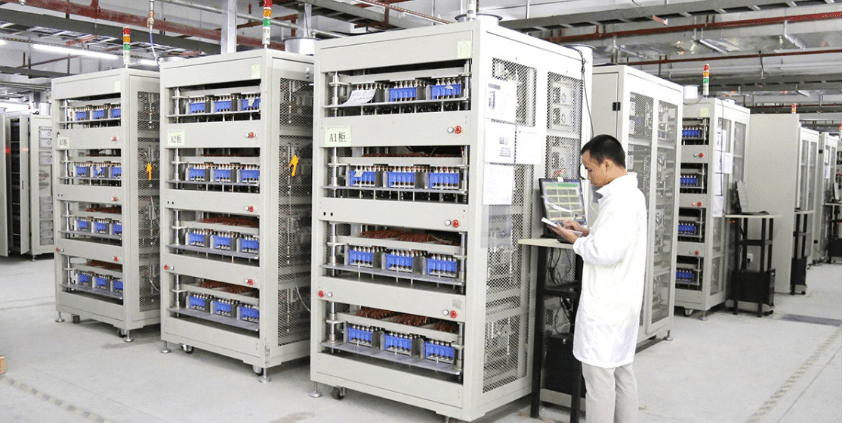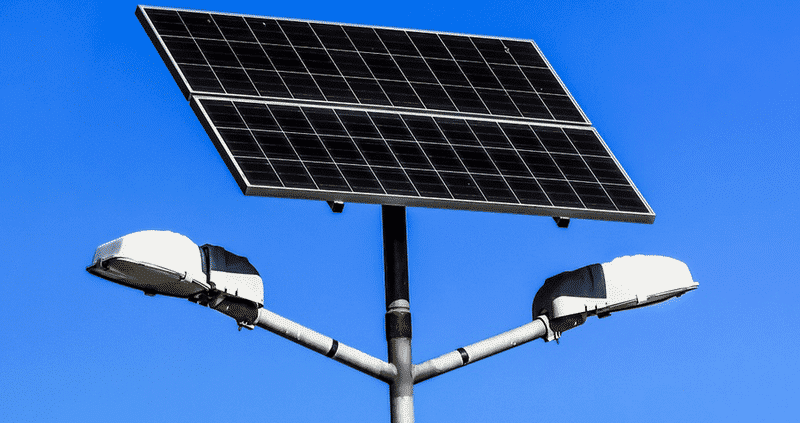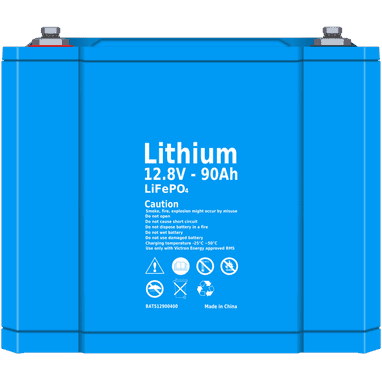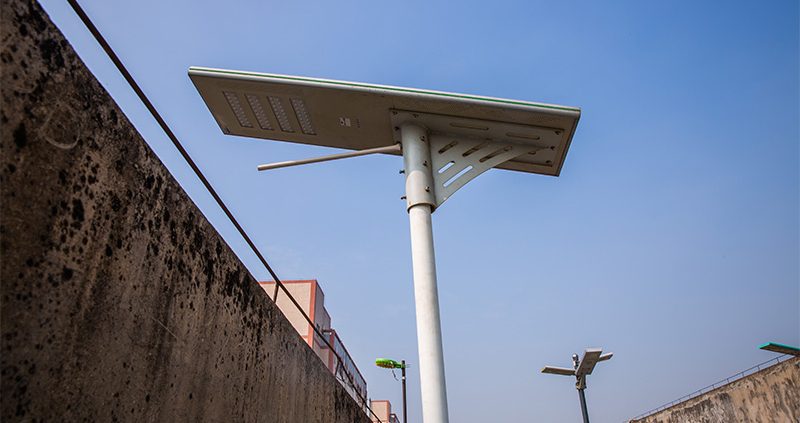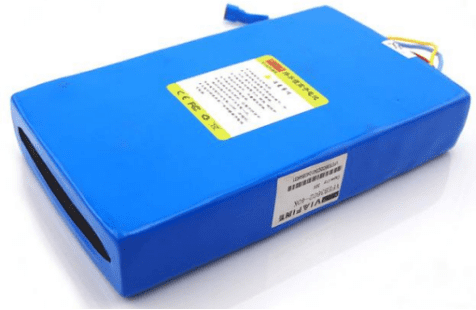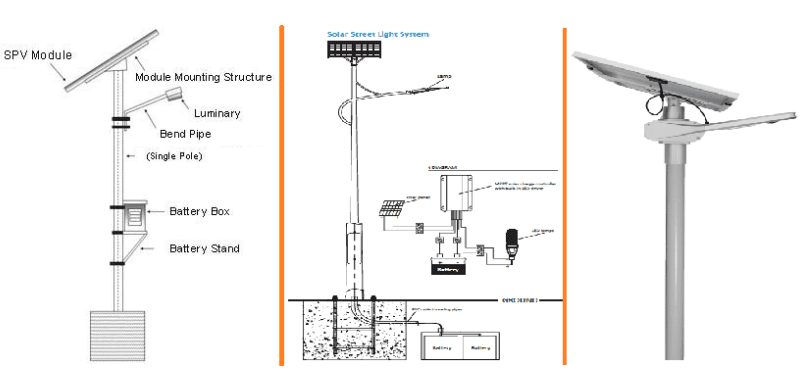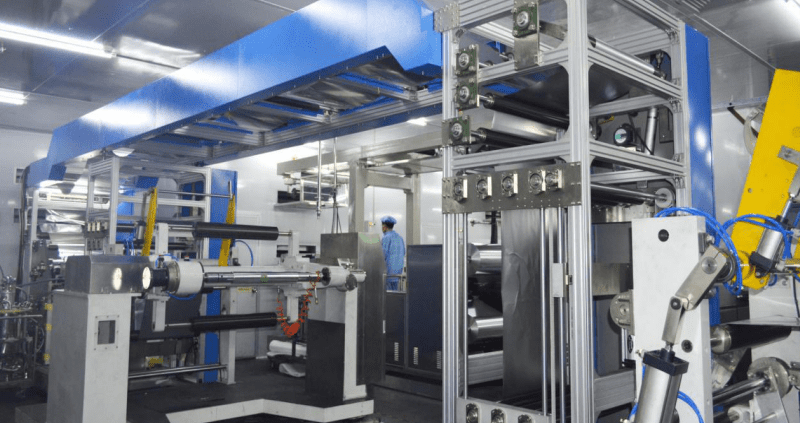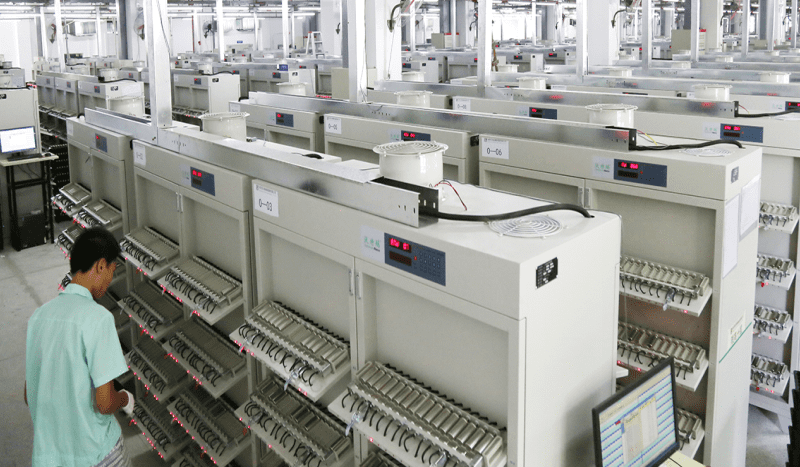Lithium-Ionen-Akku – Grundkenntnisse für den Akkupack für Solar-Straßenlaternen
(1) Zusammensetzung der Lithium-Ionen-Batterie
Ein Lithium-Ionen-Akku besteht hauptsächlich aus zwei Teilen: einer Akkuzelle und einer Schutzplatine (PCM). Die Schutzplatine wird allgemein als Batteriemanagementsystem (BMS) bezeichnet. Li-Ionen-Akkuzelle ist das Herz der Lithium-Ionen-Batterie, und das Managementsystem entspricht dem Gehirn einer Lithium-Ionen-Batterie.
Der Kern besteht hauptsächlich aus positivem Elektrodenmaterial, negativem Elektrodenmaterial, einem Elektrolyten, einer Membran und einer Hülle. Die Schutzplatte besteht hauptsächlich aus einem Schutzchip (oder Managementchip), einer MOS-Röhre, einem Widerstand, einer Kapazität und einer Leiterplatte.
(2)Vor- und Nachteile des Lithium-Ionen-Akkus
Lithium-Ionen-Akkus bieten viele Vorteile, beispielsweise eine Hochspannungsplattform, eine hohe Energiedichte (geringes Gewicht, kleines Volumen), eine lange Lebensdauer und Umweltschutz.
Die Nachteile von Lithiumbatterien bestehen darin, dass sie relativ teuer und ihr Temperaturbereich relativ eng ist und gewisse Sicherheitsrisiken bestehen (es muss ein zusätzliches Schutzsystem hinzugefügt werden).
| Vergleichsparameter verschiedener Batterien | Blei-Säure-Batterie | Nickel-Cadmium-Batterie (Ni-Cd) |
Nickel-Metallhydrid-Akku (Ni-MH) |
Lithiumbatterie |
| Nennspannung
(V) |
2 | 1.2 | 1.2 | 3.2/3.6/3.7 |
| Gewichtsenergiedichte
(Wh / kg) |
25~30 | 40~45 | 60~65 | 120~200 |
| Volumenenergiedichte
(Weiß / Schwarz) |
65~80 | 150~180 | 300~350 | 350~400 |
| Optimale Arbeitstemperatur (℃) | -40~70 | -20~60 | -20~45 | 0~45 |
| Umweltfreundlich | Bleiverschmutzung | Cadmium
Verschmutzung |
/ | / |
| Recyceln
(mal) |
200~300 | 500 | 1000 | 500~1500 |
| Kosten
(RMB/Wh) |
0.6~1.0 | 2.0~2.6 | 2.5~3.8 | 2.0~3.5 |
| Kosten des Ladegeräts | Niedrig (Stabilisierte Spannungsquelle) |
Allgemein (Konstantstromquelle) |
Allgemein
(Konstantstromquelle) |
Hoch (Konstanter Strom und Druck) |
(3) Klassifizierung von Lithium-Ionen-Batterien
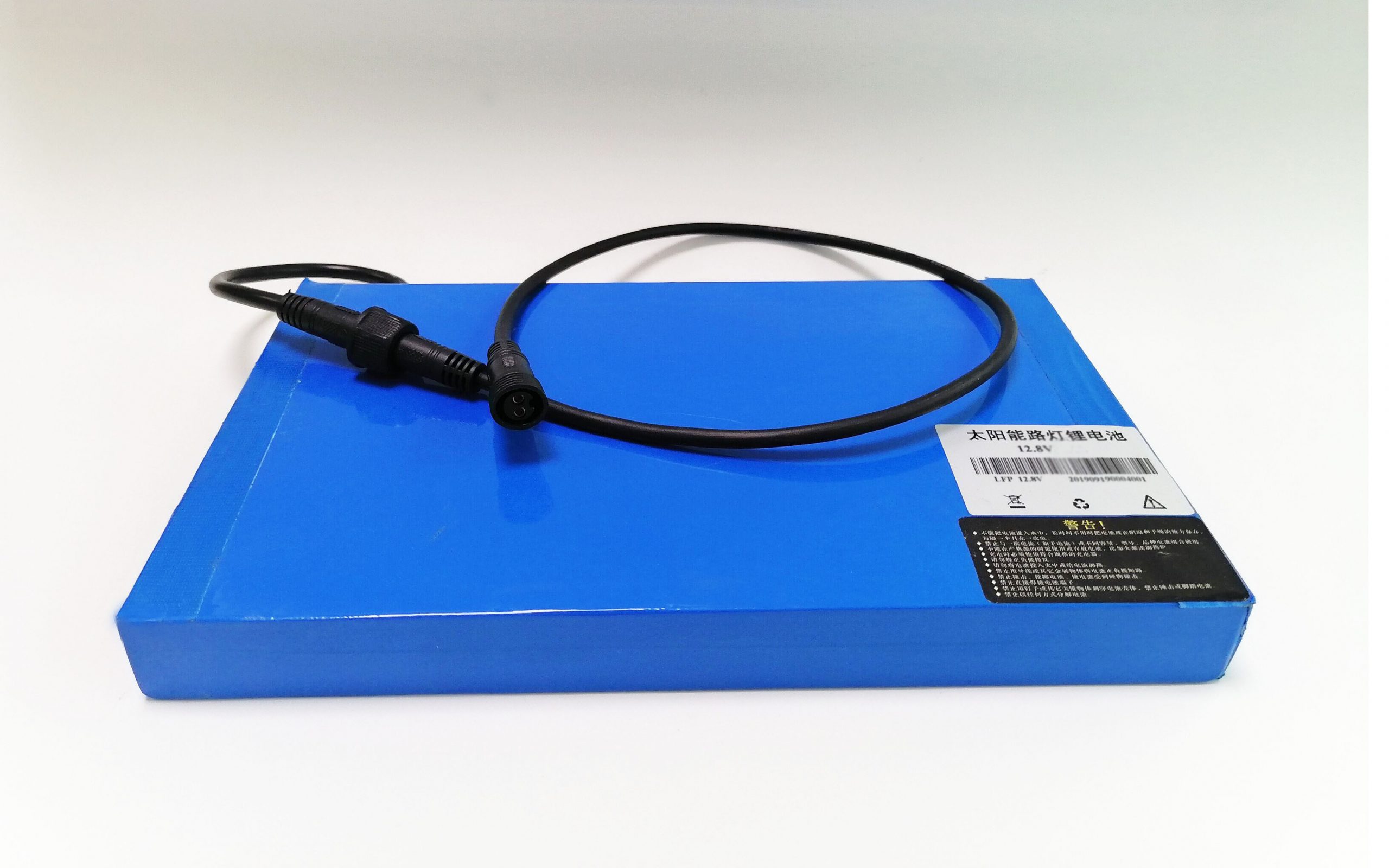
Lithiumbatterien können in zwei Kategorien unterteilt werden: Einwegbatterien und wiederaufladbare Batterien (auch als Batterien bekannt).
Nicht wiederaufladbare Batterien wie Lithium-Mangandioxid-Batterien, Lithiumsulfimid-Batterien.
Wiederaufladbare Batterien können je nach Situation in die folgenden Kategorien unterteilt werden.
- Nach Aussehen: quadratische Lithiumbatterie (wie gewöhnliche Handybatterien) und zylindrische Lithiumbatterie (wie 18650 von Elektrowerkzeugen);
- Nach den ausgelagerten Materialien: Lithiumbatterie mit Aluminiumgehäuse, Lithiumbatterie mit Stahlgehäuse und Batterie mit weicher Tasche.
- Nach den Kathodenmaterialien: Lithiumkobaltsäure (LiCoO2), Lithiummanganat (LiMn2O4), Lithiumternär (Linixcoymnzo2) und Lithiumeisenphosphat (LiFePO4);
- Nach dem Zustand des Elektrolyten: Lithium-Ionen-Batterie (LIB) und Polymerbatterie (PLB);
- Je nach Verwendungszweck: Allzweckbatterie und Power-Batterie.
- Nach Leistungsmerkmalen: Hochleistungsbatterie, Hochgeschwindigkeitsbatterie, Hochtemperaturbatterie, Niedertemperaturbatterie usw.
(4) Erläuterung allgemeiner Begriffe
- Kapazität
Es bezieht sich auf die Menge an Elektrizität, die unter bestimmten Entladebedingungen aus einer Lithiumbatterie gewonnen werden kann.
Aus dem Physikunterricht wissen wir, dass die Formel für die elektrische Größe q = I * t lautet, die Einheit Coulomb ist und die Einheit für die Batteriekapazität in Ah (Amperestunde) oder mAh (Milliamperestunde) angegeben wird. Das bedeutet, dass eine Batterie mit 1 Ah bei voller Ladung 1 Stunde lang mit einem Strom von 1 A entladen werden kann.
Früher hatte der Akku eines alten Nokia-Handys (z. B. BL-5C) normalerweise eine Kapazität von 500 mAh. Heute hat der Akku eines Smartphones 800–1.900 mAh, der Akku eines Elektrofahrrads hat normalerweise eine Kapazität von 10–20 Ah und der Akku eines Elektroautos hat normalerweise eine Kapazität von 20–200 Ah.
- Laderate / Entladerate
Sie gibt an, wie viel Strom zum Laden und Entladen verbraucht wird. Sie wird in der Regel mit einem Vielfachen der Nennkapazität des Akkus berechnet, was im Allgemeinen als „mehrere C“ bezeichnet wird.
Bei einem Akku mit einer Kapazität von 1500 mAh ist 1c = 1500 mAh angegeben. Bei einer Entladung mit 2c bedeutet dies eine Entladung mit 3000 mA Strom. Bei einer Ladung und Entladung mit 0,1c bedeutet dies eine Ladung und Entladung mit 150 mA Strom.
- Spannung (OCV: Leerlaufspannung)
Die Batteriespannung bezieht sich im Allgemeinen auf die Nennspannung einer Lithiumbatterie (auch als Nennspannung bezeichnet). Die Nennspannung einer gewöhnlichen Lithiumbatterie beträgt im Allgemeinen 3,7 V, wir nennen ihre Spannungsplattform auch 3,7 V. Wenn wir Spannung sagen, meinen wir im Allgemeinen die Leerlaufspannung der Batterie.
Wenn die Kapazität der Batterie 20-80% beträgt, konzentriert sich die Spannung auf etwa 3,7 V (3,6–3,9 V). Wenn die Kapazität zu hoch oder zu niedrig ist, ändert sich die Spannung stark.
- Energie/Leistung
Wenn die Batterie gemäß einem bestimmten Standard entladen wird, beträgt die Energie (E), die die Batterie abgeben kann, Wh (Wattstunde) oder kWh (Kilowattstunde), und 1 kWh = 1 Kilowattstunde.
Das Physikbuch enthält ein Grundkonzept: e = u * I * t, was auch der Batteriespannung multipliziert mit der Batteriekapazität entspricht.
Die Formel für die Leistung lautet p = u * I = E / T und stellt die Energie dar, die pro Zeiteinheit freigesetzt werden kann. Die Einheit ist w (W) oder kW (kW).
Bei einem Akku mit einer Kapazität von 1500 mAh liegt die Nennspannung im Allgemeinen bei 3,7 V, die entsprechende Energie beträgt also 5,55 Wh.
- Widerstand
Denn Laden und Entladen können aufgrund eines gewissen Innenwiderstands nicht mit einer idealen Stromversorgung gleichgesetzt werden. Der Innenwiderstand verbraucht Energie. Je kleiner der Innenwiderstand, desto besser.
Die Einheit des Batterieinnenwiderstandes ist Milliohm (m Ω).
Der Innenwiderstand einer Batterie setzt sich im Allgemeinen aus einem ohmschen Innenwiderstand und einem polarisierten Innenwiderstand zusammen. Die Größe des Innenwiderstands wird durch das Material, den Herstellungsprozess und den Aufbau der Batterie beeinflusst.
- Lebensdauer
Das Laden und Entladen der Batterie bezeichnet man als einen Zyklus. Die Zykluslebensdauer ist ein wichtiger Indikator zur Messung der Lebensdauer der Batterie.
Gemäß IEC-Standard muss die Lithiumbatterie des Mobiltelefons bei 0,2 C auf 3,0 V entladen und bei 1 C auf 4,2 V geladen werden. Die Batteriekapazität muss nach 500 Zyklen über 60% der Anfangskapazität liegen. Mit anderen Worten beträgt die Zyklenlebensdauer einer Lithiumbatterie 500 Zyklen.
Gemäß nationaler Norm muss die Kapazität nach 300 Zyklen bei 70% der Anfangskapazität bleiben.
Wenn die Batteriekapazität weniger als 60% der Anfangskapazität beträgt, wird sie grundsätzlich als verschrottet angesehen.
- DOD: Tiefe des Entladers
Sie wird als Prozentsatz der von der Batterie freigegebenen Nennkapazität definiert.
Im Allgemeinen ist die Batterielebensdauer umso kürzer, je tiefer die Entladungstiefe ist.
- Abschaltspannung
Die Abschlussspannung wird in Ladeabschlussspannung und Entladeabschlussspannung unterteilt, d. h. die Spannung, bei der die Batterie nicht weiter geladen oder entladen werden kann. Wenn die Batterie bei der Abschlussspannung weiter geladen oder entladen wird, wird die Batterielebensdauer erheblich beeinträchtigt.
Die Lade-/Entladeschlussspannung der Lithiumbatterie beträgt 4,2 V bzw. 3,0 V.
Es ist strengstens verboten, Lithiumbatterien über die Abschlussspannung hinaus zu laden oder zu entladen.
- Selbstentladung
Es bezieht sich auf die Rate der Kapazitätsabnahme während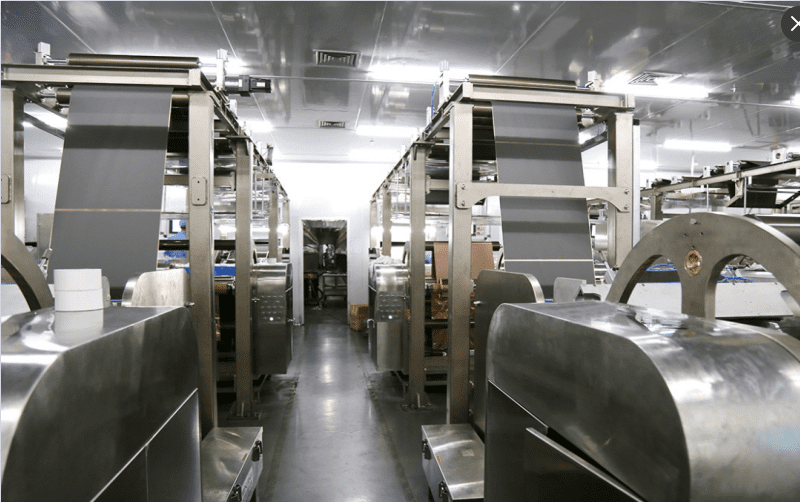 ng-Speicher, ausgedrückt als prozentualer Kapazitätsabfall pro Zeiteinheit.
ng-Speicher, ausgedrückt als prozentualer Kapazitätsabfall pro Zeiteinheit.
Die Selbstentladungsrate einer allgemeinen Lithiumbatterie beträgt 21 TP3T bis 91 TP3T/Monat.
- SOC (Ladezustand)
Dies bezieht sich auf den Prozentsatz der verbleibenden Leistung der Batterie und der Gesamtleistung, die entladen werden kann, 0 ~ 100%. Gibt die verbleibende Batterieleistung wieder.
(5) Benennungsregeln für Lithium-Ionen-Akkus
Anders Batterie Hersteller haben unterschiedliche Benennungsregeln, aber wir folgen alle einem einheitlichen Standard für allgemeine Batterien. Die Größe der Batterie kann anhand des Namens der Batterie ermittelt werden
Gemäß IEC61960 lauten die Regeln für zylindrische und quadratische Batterien wie folgt:
- Zylindrische Batterie, 3 Buchstaben gefolgt von 5 Zahlen,
Drei Buchstaben, der erste Buchstabe steht für das Material der negativen Elektrode, I bedeutet, dass ein Lithium-Ion eingebaut ist, L steht für die Lithiummetall- oder Lithiumlegierungselektrode. Der zweite Buchstabe gibt das Material der positiven Elektrode an, C steht für Kobalt, n für Nickel, m für Mangan und V für Vanadium. Der dritte Buchstabe ist R für einen Zylinder. 5 Ziffern, die ersten 2 Ziffern stehen für den Durchmesser, die letzten 3 Ziffern für die Höhe, alle in mm.
- Quadratische Batterie, 6 Ziffern nach 3 Buchstaben,
Drei Buchstaben. Die ersten beiden Buchstaben haben die gleiche Bedeutung wie ein Zylinder. Der letzte ist p, was Quadrat bedeutet.
Es handelt sich um sechs Ziffern, wobei die ersten beiden Ziffern die Dicke angeben, die mittlere die Breite und die letzten beiden die Höhe (Länge), die Einheit ist ebenfalls mm.
Beispielsweise ist ICR 18650 eine universelle zylindrische 18650-Batterie mit einem Durchmesser von 18 mm und einer Höhe von 65 mm;
ICP 053353 ist eine quadratische Batterie mit einer Dicke von 5 mm, einer Breite von 33 mm und einer Höhe (Länge) von 53 mm.
(6) Lithium-Ionen-Batterietechnologie
Es gibt einige Unterschiede im Prozessablauf verschiedener Batterien und verschiedener Hersteller, und der detaillierte Prozessablauf ist sehr komplex. Der grundlegende Prozessablauf, der Prozessablauf der Zellenherstellung und der Prozessablauf der Packherstellung sind unten aufgeführt.
Der Produktionsprozess einer elektrischen Zelle umfasst hauptsächlich die Herstellung der Polstücke, die Herstellung der elektrischen Zelle, die Montage der Batterie, die Flüssigkeitseinspritzung, die chemische Bildung, die Trennung und andere Prozesse.
Vom Dosieren bis zum Wickeln werden die positiven und negativen Elektroden gleichzeitig in verschiedenen Werkstätten hergestellt. Nachdem die positiven und negativen Elektroden hergestellt wurden, werden die nachfolgenden Prozesse gemeinsam durchgeführt. In der Mitte werden verschiedene QA-Links der Qualitätsprüfung eingefügt.
(7) Gruppen- und Serien-Parallelschaltung der Lithium-Ionen-Batterie
In verschiedenen Bereichen sind die Anforderungen an Batterien unterschiedlich. Das System hat einige spezielle Anforderungen an Spannung, Kapazität, Innenwiderstand usw. Oft kann eine einzelne Batterie die Anforderungen nicht erfüllen und muss in Reihe und parallel geschaltet werden, um die Stromversorgung nach außen zu gewährleisten.
Die Leistung von Batterien in Reihe und parallel wird durch die Leistung der schlechtesten Batterie bestimmt, was oft als „Fassprinzip“ bezeichnet wird. Daher ist der wichtigste Punkt bei der Batteriegruppierung die Konsistenz der Batterieleistungsparameter.
Beispielsweise muss bei Notebooks, Elektrofahrrädern, Elektrofahrzeugen, Energiespeichersystemen usw. die Reihen- und Parallelschaltung der Batterien zur Bildung eines Batteriepacks berücksichtigt werden.
Die Batteriespannung des Notebooks beträgt im Allgemeinen 11,1 V oder 14,8 V (hauptsächlich 18650-Batterien), also im Allgemeinen 2 in Reihe und 3 parallel oder 2 in Reihe und 4 parallel.
Das Apple iPad besteht aus drei parallel geschalteten Polymer-Akkus mit einer Kapazität von etwa 25 Wh.
Die Systeme von Elektrofahrrädern und Elektromotorrädern sind im Allgemeinen 24 V-, 36 V-, 48 V-, 60 V- und 72 V-Systeme. Die spezifischen Gruppenbedingungen finden Sie in der folgenden Tabelle (s steht für eine Reihenschaltung).
Reine Elektrofahrzeuge und Hybridelektrofahrzeuge (EV/PHEV) verfügen über eine höhere Spannung von etwa 250 bis 500 V, und die Maximalspannung beträgt bei Reihenschaltung mehr als 150 Knoten.
Darüber hinaus sind bei der Gruppierung von Batterien in einer Serien-Parallel-Schaltung viele Dinge zu beachten, wie beispielsweise die Konstanz der Batteriespannungsplattform, die Konstanz der Batteriekapazität, die Konstanz des Innenwiderstandes der Batterie usw.
Die Konstanz der Batterieparameter nach einer Serien-Parallelschaltung hat großen Einfluss auf die Leistung und Lebensdauer der Batterie.
| Akkuspannung | Lithiummanganat / ternäres Lithium | Lithiumeisenphosphat |
| 12V | 4S | 4S |
| 18 V | 5S | 6S |
| 24 V | 7S | 8S |
| 36 V | 10 Sekunden | 12S |
| 48 V | 13S | 15S/16S |
| 60 V | 16S | 19S |
| 64 V | 18S | 20er Jahre |
| 72 V | 20er Jahre | 23S |
8) Vergleich verschiedener Akkumulatoren
Bei Leistungsbatterien wird vor allem der Anwendungsbereich berücksichtigt; sie werden hauptsächlich in Elektrofahrzeugen, Elektrofahrrädern, Elektrowerkzeugen usw. verwendet.
Die Power-Batterie unterscheidet sich von einer gewöhnlichen Batterie, hat aber einige besondere Eigenschaften
- Serien- und Parallelschaltung von Batterien
- Der Akku hat eine größere Kapazität
- Die Entladerate der Batterie ist hoch (Hybridantrieb und Elektrowerkzeuge)
- Die Batterie hat höhere Sicherheitsanforderungen
- Die Batterie verfügt über einen weiten Betriebstemperaturbereich
- Die Lebensdauer der Batterie ist lang, in der Regel 5-10 Jahre
Aufgrund der Besonderheit der Leistungsbatterie gibt es einige Unterschiede in ihrem Verfahren und ihren Materialien. Je nach Situation der positiven Elektrodenmaterialien wird es hauptsächlich in Lithiummanganat (LiMn2O4), Lithiumternär (Linixcoymnzo2), Lithiumeisenphosphat (LiFePO4) usw. unterteilt. Spannungsplattform, Energiedichte, Preis, Sicherheit usw. weisen alle gewisse Unterschiede auf. Weitere Einzelheiten finden Sie im Vergleich in der folgenden Tabelle:
(Lithiumkobaltit wird aufgrund seiner mangelnden Stabilität und seines hohen Preises, der in der folgenden Tabelle aufgeführt und verglichen wird, selten als Leistungsbatterie verwendet)
| Artikel | Spezifikation | Kobaltsäure Lithium | Ternäres Lithium | Lithiummanganat | Lithiumeisenphosphat |
| 1 | Stampfdichte (g/cm3) | 2.8~3.0 | 2.0~2.3 | 2.2~2.4 | 1.0~1.4 |
| 2 | Spezifische Oberfläche (m2/g) | 0.4~0.6 | 0.2~0.4 | 0.4~0.8 | 12~20 |
| 3 | Kapazitätsdichte (Ah/kg) | 135~140 | 155~165 | 100~115 | 130~140 |
| 4 | Plattformspannung (V) | 3.7 | 3.6 | 3.6 | 3.2 |
| 5 | Recyclingzeiten | >300 | >800 | >500 | >2000 |
| 6 | Übergangsmetall | Arm | Arm | Reich | Viel reich |
| 7 | Materialkosten | Sehr hoch | Hoch | Niedrig | Niedrig |
| 8 | Umweltfreundlich | Kobalt | Enthält Nickel und Kobalt | / | / |
| 9 | Sicherheit | Arm | Allgemein | Gut | Exzellent |
| 10 | Anwendung | Kleine Batterie | Kleine Batterie, Kleine Power-Batterie | Akku | Power-Akku, Netzteil mit Superkapazität |
(9) Lithiumbatteriemodell
In Bezug auf die elektrischen Eigenschaften ist der Innenwiderstand der Batterie nicht vollständig mit einem Widerstand äquivalent. Einzelheiten entnehmen Sie bitte dem ausländischen PNGV-Ersatzschaltbildmodell. Wie in der Abbildung unten gezeigt.
Der Innenwiderstand der Batterie setzt sich im Wesentlichen aus dem ohmschen Widerstand R0 und dem Polarisationswiderstand R1 zusammen, wobei C1 die Polarisationskapazität ist.
In der Industrie gibt es zwei Haupttestmethoden zur Messung des Innenwiderstands von Batterien. Die Gleichstromentladungsmethode und die Wechselstromeinspeisungsmethode. Der Widerstand kann nicht mit der herkömmlichen Methode gemessen werden, sondern nur mit einem speziellen Messgerät für den Innenwiderstand.
Der Innenwiderstand der Batterie ist ein wichtiger Parameter, der die Leistung und Lebensdauer der Batterie widerspiegelt. Wenn sich die Zyklenlebensdauer der Batterie nähert, steigt der Innenwiderstand der Batterie stark an. Die Beziehung zwischen der Anzahl der Zyklen und dem Innenwiderstand ist in der folgenden Abbildung dargestellt.
10) Elektrische Eigenschaften und Schlüsselparameter der Lithium-Ionen-Batterie
- Die Lade-Entladekurve der Batterie
Die Lade- und Entladekurve einer Lithiumbatterie bezieht sich auf die Beziehungskurve zwischen Batteriekapazität und Leerlaufspannung. Anhand der Entladekurve kann die Leistung der Batterie grob geschätzt werden, wie in der folgenden Abbildung dargestellt.
Die Lade-Entlade-Kurve einer Lithiumbatterie hängt nicht nur vom Lade- und Entladestrom, sondern auch von der Temperatur ab. Wie in der Abbildung unten gezeigt.
- Schlüsselparameter der Batterie
Aufgrund ihrer Eigenschaften kann eine Lithiumbatterie nicht überladen, überentladen, überladen oder überhitzt werden. Aus Sicherheitsgründen und im Hinblick auf die Batterielebensdauer sollte die Batterie daher angemessen geschützt werden. Es gibt mehrere Parameter, die häufig auftreten und parallel aufgeführt sind. Zwischen verschiedenen Herstellern gibt es kaum Unterschiede in der Spannung. Es gibt jedoch einige Unterschiede zwischen Batterien mit unterschiedlichen Betriebstemperaturen, unterschiedlichen Entladeraten oder unterschiedlichen Herstellern.
| Vergleichsartikel | Manganat-Lithium/Ternäres Lithium | Lithiumeisenphosphat |
| Stromspannung | 3,7 V/3,6 V | 3,2 V |
| Ladeschlussspannung | 4,2 V | 3,6 V |
| Entladeschlussspannung | 3,0 V | 2,0 V |
| Betriebstemperatur | -20~60℃ | -10~65℃ |
| Maximale Entladerate | 3~10 °C | 3~10 °C |
11) Anforderungen und Systeme zum Schutz und Management von Lithium-Ionen-Batterien
Aufgrund der Eigenschaften von Lithiumbatterien ist es erforderlich, eine Batterieschutzplatine (PCM) oder ein Batteriemanagementsystem (BMS) hinzuzufügen. Batterien ohne Schutzplatine oder Managementsystem dürfen nicht verwendet werden und es bestehen enorme Sicherheitsrisiken. Sicherheit hat bei Batteriesystemen immer oberste Priorität.
Bei unzureichendem Schutz oder Umgang mit der Batterie besteht die Gefahr einer Verkürzung der Lebensdauer, einer Beschädigung oder einer Explosion.
Das PCM (Power Circuit Module) wird hauptsächlich in Verbraucherprodukten wie Mobiltelefonen und Notebooks verwendet.
Batteriemanagementsysteme (BMS) werden hauptsächlich in Antriebsbatterien, beispielsweise in Elektrofahrzeugen, Elektrofahrrädern, Energiespeichern und anderen Großsystemen verwendet.
Zu den Hauptfunktionen von PCM gehören OVP, UVP, OTP, OCP usw. Im Falle einer Anomalie wird das System automatisch abgeschaltet, um die Systemsicherheit zu gewährleisten.
Die Technologie für Batterieschutzsysteme ist sehr ausgereift. Es gibt viele entsprechende Platinenfabriken, die sich hauptsächlich in Südchina befinden. Und es gibt spezielle IC-Hersteller, die spezielle Lithiumbatterie-Schutzchips anbieten. Dieses Teil ist relativ ausgereift und es gibt in China viele ausgereifte Schutz-IC-Chips.
Zu den Hauptfunktionen des Batteriemanagementsystems (BMS) gehören neben den grundlegenden Schutzfunktionen des Schutzsystems die Messung von Batteriespannung, Temperatur und Strom, Energiebilanz, SOC-Berechnung und -Anzeige, Alarm von anormalen Zuständen, Lade- und Entlademanagement, Kommunikation usw. Einige BMS-Systeme integrieren zudem Wärmemanagement, Batterieerwärmung, Analyse des Batteriezustands (SOH), Messung des Isolationswiderstands usw.
Einführung und Analyse der BMS-Funktion:
- Der Batterieschutz ähnelt dem PCM und umfasst Schutz vor Überladung, Überentladung, Übertemperatur, Überstrom und Kurzschluss. Wie bei gewöhnlichen Lithium-Mangan-Batterien und ternären Lithium-Batterien unterbricht das System automatisch den Lade- oder Entladestromkreis, sobald die Spannung einer Batterie 4,2 V überschreitet oder unter 3,0 V fällt. Wenn die Temperatur der Batterie die Betriebstemperatur der Batterie überschreitet oder der Strom größer als der Entladestrom der Batterie ist, unterbricht das System automatisch den Strompfad, um die Sicherheit der Batterie und des Systems zu gewährleisten.
- Der Energiehaushalt des gesamten Akkupacks weist nach einer gewissen Betriebszeit große Unterschiede auf, die darauf zurückzuführen sein können, dass viele Akkus in Reihe geschaltet sind, die Zelle selbst inkonsistent ist, die Betriebstemperatur inkonsistent ist oder andere Gründe vorliegen. Dies hat große Auswirkungen auf die Lebensdauer des Akkus und die Nutzung des Systems. Der Energiehaushalt gleicht die Unterschiede zwischen einzelnen Zellen durch aktives oder passives Lade- oder Entlademanagement aus, um die Akkukonsistenz sicherzustellen und die Akkulebensdauer zu verlängern.
In der Branche gibt es zwei Arten von Methoden: passive und aktive Entzerrung. Die passive Entzerrung dient hauptsächlich dazu, die durch den Widerstand verbrauchte Energiemenge auszugleichen. Die aktive Entzerrung dient hauptsächlich dazu, die Energie von Batterien mit mehr Leistung durch Kapazität, Induktivität oder Transformator auf Batterien mit weniger Leistung zu übertragen. Der Vergleich zwischen passiver und aktiver Entzerrung ist in der folgenden Tabelle dargestellt.
Da das aktive Gleichgewichtssystem relativ komplex und die Kosten relativ hoch sind, ist der Mainstream immer noch das passive Gleichgewicht.
| Vergleichsartikel | Passives Gleichgewicht | Aktives Gleichgewicht |
| Gleichgewichtsmodus | Widerstandsverbrauch | Induktive Äquivalentübertragung |
| Gleichgewichtseffizienz | Niedrig | Hoch |
| Programmreife | reifen | Reifer |
| Systemkomplexität | Niedrig | Hoch |
| Systemkosten | NIEDRIG | Hoch |
- SOC-Berechnung, die Berechnung der Batterieleistung ist ein sehr wichtiger Teil des BMS. Viele Systeme müssen die verbleibende Leistung genauer kennen. Aufgrund der technologischen Entwicklung gibt es viele Methoden zur SoC-Berechnung. Wenn die Genauigkeitsanforderungen nicht hoch sind, kann die Restleistung anhand der Batteriespannung beurteilt werden. Die wichtigsten und genauesten Methoden sind die Stromintegrationsmethode (auch ah-Methode genannt), q = ∫ I DT, Innenwiderstandsmethode, neuronale Netzwerkmethode, Kalman-Filtermethode usw. Der aktuelle Mainstream in der Branche ist immer noch die aktuelle Bewertungsmethode.
- Kommunikation. Unterschiedliche Systeme haben unterschiedliche Anforderungen an Kommunikationsschnittstellen. Die gängigen Kommunikationsschnittstellen sind SPI, I2C, CAN, RS485 usw. In Automobil- und Energiespeichersystemen kommen hauptsächlich CAN und RS485 zum Einsatz.
Aufgrund des mangelnden Wettbewerbs und der Komplexität des BMS-Systems gibt es relativ wenige Systemhersteller. Die entsprechenden Chiphersteller sind hauptsächlich europäische und amerikanische Hersteller, und es gibt auch einige große Unternehmen in China. Es gibt in Zukunft viele Möglichkeiten.
Ich hoffe, dass ich Ihnen eine E-Mail senden kann, um mit Ihnen über die Technologie, Produkte und Hersteller von BMS zu kommunizieren.
(12) Anforderungen und Systeme zum Laden von Lithium-Ionen-Akkus
Die gängige Lademethode für Lithiumbatterien ist konstanter Strom und konstante Spannung (CC / CV): konstanter Strom – konstante Spannung. Zuerst wird mit konstantem Strom geladen und dann mit konstanter Spannung, nachdem ein bestimmtes Potenzial erreicht wurde. Ein gutes Ladegerät kann auch je nach Batteriespannungszustand langsam laden. Einige Systeme verfügen auch über einen Impulslademodus auf der Rückseite und stellen das Ende des Ladevorgangs zeitabhängig ein.
Allgemeine Ladegeräte integrieren Funktionen wie Strombegrenzung, Spannungsbegrenzung, Überspannungsschutz, Überstromschutz, Übertemperaturschutz und Rückwärtsanschlussschutz. Das spezifische Ladesystem ist in der folgenden Abbildung dargestellt.
Darüber hinaus wird das Laden des Ladegeräts normalerweise mit PCM oder BMS kombiniert, um in der Ladephase mit konstanter Spannung einen Energieausgleich durchzuführen.
Bei einer gewöhnlichen Lithium-Kobaltoxid-Batterie beginnt das Ladegerät mit der Erhaltungsladung (ca. 0,1 C), wenn die Batteriespannung unter 3,0 V liegt, um Schäden an der Batterie zu vermeiden. Wenn die Batteriespannung auf 3,0 V geladen ist, wird auf Konstantstromladung umgestellt (ca. 1 C, der Strom hängt vom System ab). Es wird erkannt, dass die Batteriespannung auf Konstantspannungsladung umgestellt wird, wenn die Batteriespannung 4,1 V erreicht. Wenn der Batteriestrom auf ca. 0,1 C abfällt, ist der Ladevorgang abgeschlossen und das Ladesystem und der Ladekreis werden geschlossen. Die Ladekurve ist in der folgenden Abbildung dargestellt.
Je nach Leistung verwendet das Ladegerät unterschiedliche Steuerungstechnologien. Die lineare Stromversorgung ist das Hauptschema für niedrige Leistung und die Schaltstromversorgung ist das Hauptschema für hohe Leistung. Die Ladetechnologie ist ziemlich ausgereift, die Leistung und Effizienz des Ladegeräts können grundsätzlich ein relativ gutes Niveau erreichen. Es gibt viele entsprechende Hersteller. Die wichtigsten Technologien des Ladegeräts sind hauptsächlich Stromversorgungstechnologie und Batterietechnologie. Die entsprechenden Hersteller haben auch schon zuvor Stromversorgungen hergestellt.
(13) Anwendungsbereiche von Lithiumbatterien
Batterien werden hauptsächlich in Konsumgütern, digitalen Produkten, Stromprodukten, der Medizin und in der Sicherheitstechnik verwendet.
| Triebkraft | Unterhaltungselektronik | Digitales | Gesundheitspflege | Sicherheit | Elektrothermisch | Sonstiges |
| Elektroauto | Mobiltelefon | Digitalkamera | Palm-Elektrokardiograph | Feuer-Notlicht | Warme Kleidung | Elektronisches Menü |
| Elektrofahrrad | Notizbuch | Digitales Vidicon | Vitalzeichen-Monitor | Überwachungskamera | Heiztücher | Elektrorasierer |
| Elektromotorrad | Tablet-PC | Bluetooth-Headset | Ein tragbares Ultraschalldiagnosegerät | POS-Gerät | Handwärmer | Kabelloses Laden |
| Energiespeichersystem | Netbooks | Drahtlose Maus | Tragbares Oximeter | Drahtloser Anruf | Beheizte Innensohle | Militärische Ausrüstung |
| Backup-Stromversorgungen | MITTE | Bluetooth-Tastatur | Tragbarer Fetalgeräuschmonitor | Drahtlose Türklingel | Warme Handschuhe | Bohrlochortung |
| Elektrowerkzeug | GPS | Auto-Kit | Laser-Behandlungsinstrument | Zutrittskontrollsystem | Suchscheinwerfer | |
| Modellflugzeug | E-Buch | LED-Taschenlampe | Drahtlose elektronische medizinische | Fingerabdruck-Identifikation | LED-Bildschirm | |
| Kabelloser Lautsprecher | Endoskop | RFID-Überwachung | LED Solar Straßenlaterne | |||
| Augenpflege | Zig Bee Diebstahlschutz | |||||
| Physiotherapie-Produkte |

